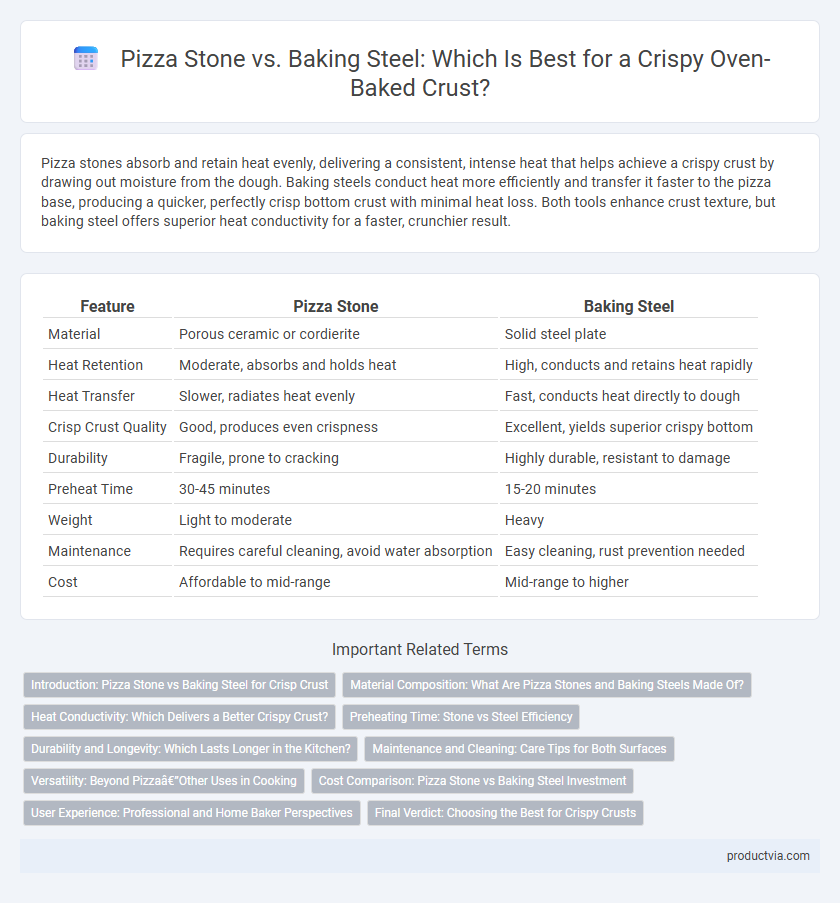Pizza stones absorb and retain heat evenly, delivering a consistent, intense heat that helps achieve a crispy crust by drawing out moisture from the dough. Baking steels conduct heat more efficiently and transfer it faster to the pizza base, producing a quicker, perfectly crisp bottom crust with minimal heat loss. Both tools enhance crust texture, but baking steel offers superior heat conductivity for a faster, crunchier result.
Table of Comparison
| Feature | Pizza Stone | Baking Steel |
|---|---|---|
| Material | Porous ceramic or cordierite | Solid steel plate |
| Heat Retention | Moderate, absorbs and holds heat | High, conducts and retains heat rapidly |
| Heat Transfer | Slower, radiates heat evenly | Fast, conducts heat directly to dough |
| Crisp Crust Quality | Good, produces even crispness | Excellent, yields superior crispy bottom |
| Durability | Fragile, prone to cracking | Highly durable, resistant to damage |
| Preheat Time | 30-45 minutes | 15-20 minutes |
| Weight | Light to moderate | Heavy |
| Maintenance | Requires careful cleaning, avoid water absorption | Easy cleaning, rust prevention needed |
| Cost | Affordable to mid-range | Mid-range to higher |
Introduction: Pizza Stone vs Baking Steel for Crisp Crust
A pizza stone and baking steel both enhance crust crispness by improving heat retention and distribution in home ovens. Pizza stones, made from ceramic or cordierite, absorb moisture and provide even heat, resulting in a slightly chewier texture. Baking steels, constructed from thick steel plates, transfer heat more efficiently than stones, producing a faster bake and a crispier, well-charred crust favored by professional pizzaiolos.
Material Composition: What Are Pizza Stones and Baking Steels Made Of?
Pizza stones are typically made of ceramic, cordierite, or clay, which absorb and retain heat to create a crisp crust by evenly distributing warmth and drawing moisture away from the dough. Baking steels, constructed from solid steel or carbon steel, conduct heat faster and more efficiently than pizza stones, resulting in a quicker and more intense browning of the crust. The superior thermal conductivity of steel offers a distinct advantage in achieving a crispy, evenly baked pizza base compared to the porous, heat-retentive properties of pizza stones.
Heat Conductivity: Which Delivers a Better Crispy Crust?
Pizza stones and baking steels differ significantly in heat conductivity, directly impacting crust crispiness; baking steel boasts a much higher thermal conductivity, around 15 W/m*K compared to pizza stone's 1.3 W/m*K. This superior heat transfer allows baking steel to rapidly and evenly distribute heat, producing a more consistent and crisp crust by quickly setting the dough's exterior while retaining moisture inside. While pizza stones offer gradual heat absorption for even cooking, baking steels excel in delivering a superior crispy crust due to their efficient thermal conductivity.
Preheating Time: Stone vs Steel Efficiency
Pizza stones typically require 45 minutes to an hour of preheating to reach optimal baking temperature, providing steady, even heat for a crisp crust. Baking steel heats up faster, often reaching desired temperatures within 20 to 30 minutes, due to its excellent thermal conductivity and heat retention properties. This efficiency contributes to quicker cooking times and consistently crispier pizza crusts compared to pizza stones.
Durability and Longevity: Which Lasts Longer in the Kitchen?
Baking steels generally offer greater durability and longevity compared to pizza stones, as their solid steel construction resists cracking and chipping over time. Pizza stones, often made of ceramic or cordierite, can crack if exposed to thermal shock or mishandling, reducing their lifespan in the kitchen. The corrosion-resistant properties of baking steel ensure consistent performance for years, making it a preferred choice for cooks seeking a long-lasting tool for achieving a crisp crust.
Maintenance and Cleaning: Care Tips for Both Surfaces
Pizza stones require careful maintenance to prevent cracking, including avoiding rapid temperature changes and cleaning only with a dry brush to remove debris. Baking steels, made of durable metal, are easier to clean by wiping or gentle scrubbing without worrying about damage or seasoning. Both surfaces benefit from regular cleaning after use, but baking steels offer more resilience and lower maintenance compared to the porous and delicate nature of pizza stones.
Versatility: Beyond Pizza—Other Uses in Cooking
Pizza stones offer excellent heat retention for crisp crusts and are ideal for baking bread, cookies, and pastries, providing even cooking and moisture absorption. Baking steels conduct heat faster and higher, making them versatile for searing meats, roasting vegetables, and achieving a perfect crust on various baked goods. Both tools enhance oven performance but differ in heat conduction and applications beyond pizza preparation.
Cost Comparison: Pizza Stone vs Baking Steel Investment
Pizza stones generally cost between $20 and $50, offering an affordable option for achieving a crisp crust by evenly distributing heat. Baking steels, priced around $70 to $150, provide superior heat conductivity and durability but require a higher initial investment. Evaluating long-term performance and cooking quality can justify the additional cost of a baking steel for serious home bakers.
User Experience: Professional and Home Baker Perspectives
Pizza stones offer excellent heat retention and even cooking, creating a consistently crisp crust prized by home bakers for its authenticity and affordability. Baking steels provide superior heat conductivity, greatly reducing cook time and producing a dramatically crispier crust, favored by professionals seeking speed and precision in high-volume environments. Both tools enhance user experience by leveraging distinct thermal properties, with baking steels excelling in responsiveness and pizza stones in maintaining steady heat.
Final Verdict: Choosing the Best for Crispy Crusts
A pizza stone absorbs moisture and distributes heat evenly, creating a well-cooked, crispy crust with a traditional texture. Baking steel conducts heat faster and retains higher temperatures, resulting in a superior crust with crispier edges and a quicker bake time. For achieving the crispiest crusts quickly, baking steel is the optimal choice, while pizza stone is ideal for those seeking authentic crispness with gradual, even heat.
Pizza stone vs Baking steel for crisp crust Infographic

 productvia.com
productvia.com